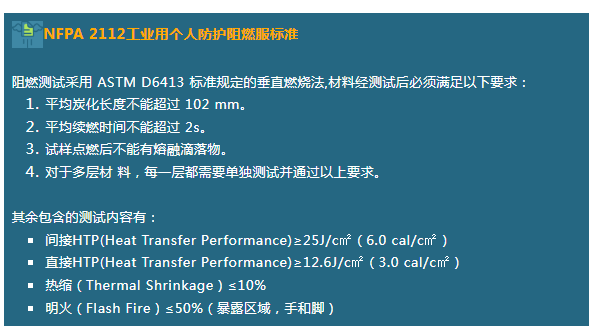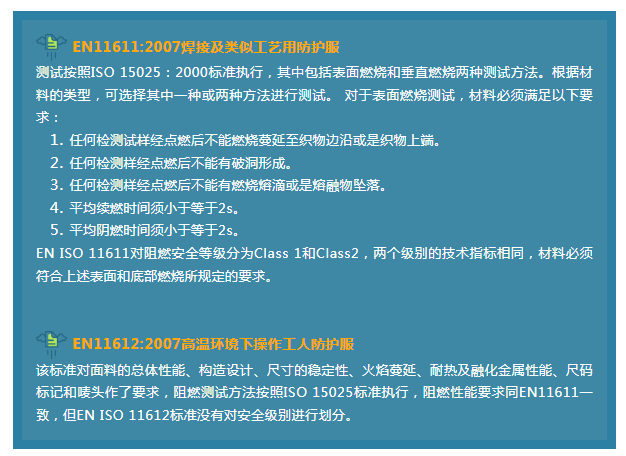Flame retardant fabric testing standards and testing methods
What is flame retardant fabric
It is processed by special production technology to effectively prevent the spread of flames. Textiles after flame-retardant finishing will not burn when exposed to fire sources. Instead, they can reduce the flammability of the fabric in flames, slow down the spread of flames, and prevent the formation of large areas. It burns; and after leaving the flame, it can self-extinguish quickly and no longer burn or smolder. Has good durable washing properties.
The main processes include: THPC (water-soluble flame retardant penetrates into the fiber, turns into a polymer after ammonia fumigation chemical reaction, and is permanently cross-linked with the fiber), CP (Pyrovatex)
American standard
The National Fire Protection Association has formulated a series of standards for the technical performance of different flame-retardant protective clothing. The main ones related to flame-retardant fabrics are NFPA2112

EU standards
The EU’s flame retardant testing standards for protective clothing are mainly formulated by the European Technical Committee (CEN/TC). The current standards include EN ISO 11611:2007, EN ISO 11612:2008, EN ISO 14116:2008/AC:2009

Chinese standards
Standards for firefighting clothing and welding clothing GB 8965.1-2009, issued by the General Administration of Quality Supervision, Inspection and Quarantine of the People’s Republic of China and the National Standardization Administration of China.

Test Methods
1 vertical method
This test method stipulates that the sample is placed vertically (the length direction of the sample is perpendicular to the horizontal line), the combustion source ignites the sample below the sample, and the minimum ignition time, afterburning time, flame retardant time, and flame spread of the sample are tested. Indicators related to flame retardant performance include speed, carbonization length (damage length), carbonization area (damage area), etc. The vertical burning method is mainly used for flame retardant testing of clothing textiles, curtains and other fabrics.
Common vertical test standards:
GB/T 5455 Textile combustion performance test
GB/T 8745 Textile combustion properties – Determination of fabric surface burning time
CA TB117 California fire retardant test
16 CFR 1615/1616 Flammability Standard for Children’s Pajamas
245°tilt method
This test method stipulates that the sample is placed at an angle of 45° (the length direction of the sample is at an angle of 45° to the horizontal). The combustion source ignites the sample on the upper or lower surface below the sample, and the distance the sample burns upward is measured. The required time, or measuring the afterburning of the sample after burning, flame retardant time, flame spread speed, charring length, charring area, or measuring the number of times the sample needs to be contacted with the flame at a certain distance from the lower end of the sample, etc. are related to the flame retardant performance. instructions. The 45° tilt method is mainly used for flame retardant testing of carpets and other fabrics.
Common tilt method test standards:
GB/T 14645 Textile fabric combustion performance: Determination of damage area and number of flame encounters in 45° direction
ASTM D 1230 Test Method for Flammability of Clothing Textiles
NFPA 702 California flame retardant standard for hospital clothing and bedding fabrics
BIFMA Standard for Testing of Interior Decorative Materials
3 level method
This test method stipulates that the sample is placed horizontally, ignited at the head end of the sample, the distance the flame spreads on the sample and the time it takes to spread this distance are measured, the burning rate is calculated, and the burning rate is used to characterize the flame retardancy of the fabric. The horizontal method is mainly used for flame retardant testing of automotive interior decoration materials.
Common proficiency test standards:
FZ/T 01028 Level method for determination of combustion properties of textile fabrics
GB 8410 Combustion characteristics of automotive interior materials
FMVSS302 (USA) Combustion Properties of Interior Decorative Materials for Federal Transportation Vehicles
IEC 60695-11-10 Fire hazard test Part 11-10: Test method for 50W horizontal and vertical flames.





